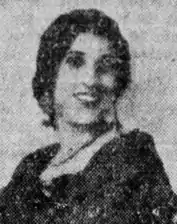Luisa Espinel
Luisa Espinel (December 8, 1892 – February 2, 1963), born Luisa Ronstadt, was an American singer, dancer, and actress. She toured, taught, performed in vaudeville, and appeared in a movie with Marlene Dietrich.
Luisa Espinel | |
|---|---|
 Luisa Espinel, from a 1928 newspaper. | |
| Born | Luisa Ronstadt December 8, 1892 Tucson, Arizona |
| Died | February 2, 1963 (aged 70) Los Angeles, California |
| Occupation(s) | Singer, dancer, actress |
| Parent | Federico José María Ronstadt |
| Relatives | Linda Ronstadt (niece) |
Early life
Luisa Ronstadt was born in Tucson, Arizona in 1892, the daughter of Mexican-born businessman and musician Federico José María Ronstadt, and his wife Sara Levin.[1] Her mother died in 1902, from a fever,[2][3] and her father remarried, to Lupe Dalton; one of their granddaughters was singer Linda Ronstadt,[4] who recalled "visits from Aunt Luisa" as "wonderfully exciting."[5][6] Luisa Espinel went to San Francisco, New York, and Paris to study music;[7] she went to Spain to study Spanish music and dance in the 1920s.[8][9]
Career
Espinel toured as a dancer and singer in the western states[10][11][12][13] and in vaudeville.[8] She was a member of the Mexican Players of Claremont, California in the 1930s.[8] She taught music and dance in Los Angeles, toured and gave concerts in folk-inspired costumes,[14][15] and danced in the film The Devil Is a Woman (1935), starring Marlene Dietrich.[7] In 1946 she compiled a book of traditional lyrics, Canciones de mi padre: Spanish Folksongs from Southern Arizona, released by University of Arizona.[8] In the 1950s, she taught Spanish to adults in Pasadena,[16] and was a presenter at the Casa de Adobe, a recreated Californio residence at the Southwest Museum.[17]
Personal life
In 1935,[18] Espinel became the second wife of the American artist Charles Kassler, and was a model for his 1934 mural "Pastoral California", in Fullerton, California.[19] She died in 1963, aged 71, in Los Angeles.[20] Her papers are in the Ronstadt family collections at the University of Arizona and the Arizona Historical Society libraries.[8][3]
References
- Griffith, James J. "The Singing Ronstadts and Canciones de mi Padre: A Musical Family". Through Our Parents' Eyes. Retrieved April 19, 2020.
- Marin, Christine (2009). "Luisa Ronstadt Espinel: Music Ambassador to the World". Arizona Memory Project. Retrieved April 19, 2020.
- Ronstadt Family Collection, Arizona Historical Society, Tucson AZ.
- "Linda Wasn't First in Music or Fame in Ronstadt Family; Luisa Ronstadt Espinel Told World about Spanish Folk Songs". Tucson Citizen. October 10, 1988. p. 24. Retrieved April 20, 2020 – via Newspapers.com.
- Bommersbach, Jana (April 1, 2006). "The First Ronstadt Superstar". True West Magazine. Retrieved April 19, 2020.
- Ronstadt, Linda (September 2, 2014). Simple Dreams: A Musical Memoir. Simon and Schuster. p. 4. ISBN 978-1-4516-6873-5.
- Sheridan, Thomas E.; Noriega, Joseph (1984). "FROM LUISA ESPINEL TO LALO GUERRERO: Tucson's Mexican Musicians Before World War II". The Journal of Arizona History. 25 (3): 285–300. ISSN 0021-9053. JSTOR 41859599.
- Koegel, John (2013). "Espinel, Luisa". Grove Music Online. doi:10.1093/gmo/9781561592630.article.A2262240. ISBN 978-1-56159-263-0. Retrieved April 19, 2020.
- "Luisa Espinel to Sing Original Songs of Spain". El Paso Herald. December 4, 1929. p. 15. Retrieved April 20, 2020 – via Newspapers.com.
- Sheridan, Thomas E. (May 26, 2016). Los Tucsonenses: The Mexican Community in Tucson, 1854–1941. University of Arizona Press. p. 190. ISBN 978-0-8165-3442-5.
- "Luisa Espinel at Temple". Arizona Daily Star. November 26, 1933. p. 14. Retrieved April 20, 2020 – via Newspapers.com.
- "To Present Song Pictures; Senorita to be Heard Tomorrow". Fort Worth Record-Telegram. November 1, 1928. p. 6. Retrieved April 20, 2020 – via Newspapers.com.
- Martínez, Matilde Olarte (November 15, 2017). Luisa Espinel, Rebeca Switzer y Miirrha Alhambra: alma mater de las veladas musicales de la Casa Hispánica en la Universidad de Columbia: EN Liberales, cultivadas y activas: redes culturales, lazos de amistad (in Spanish). Ediciones Universidad de Salamanca.
- "Luisa Espinel, Diseuse, assisted by Nino Herschel, Pianist, "Song Pictures of Spain", Grand Ballroom, Multnomah Hotel, January 31, 1929". The Gallery. May 5, 2015. Retrieved April 19, 2020.
- Jones, Isabel Morse (August 13, 1933). "Romantic History of Spain Made Vivid by Luisa Espinel". The Los Angeles Times. p. 31. Retrieved April 19, 2020 – via Newspapers.com.
- "New Spanish Class Benjamin Franklin Adult School". South Pasadena Review. September 10, 1953. p. 6. Retrieved April 20, 2020 – via Newspapers.com.
- "Civic Groups to Meet at Museum's Spanish Home". The Los Angeles Times. April 10, 1955. p. 46. Retrieved April 20, 2020 – via Newspapers.com.
- "Social Events". Arizona Daily Star. April 26, 1935. p. 9. Retrieved April 20, 2020 – via Newspapers.com.
- Cruz, Mimi Ko (September 7, 1997). "The Renaissance of a Fullerton Mural". The Los Angeles Times. Retrieved March 22, 2021.
- "Luisa R. (Espinel) Kassler death notice". The Los Angeles Times. February 4, 1963. p. 46. Retrieved April 20, 2020 – via Newspapers.com.
External links
- Photographs of Luisa Espinel in the collection of the Autry Museum of the American West.
- Luisa Espinel at IMDb
- The Devil is a Woman (1935), on Internet Archive.